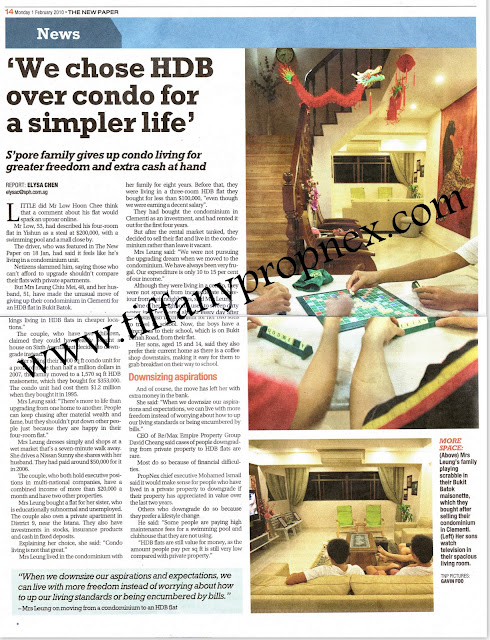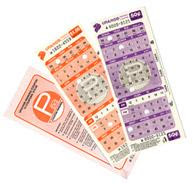
ST Article: New Jurong leisure centre gets go-ahead
ST article 23 January 2010
New Jurong leisure centre gets go-ahead (Previous Jurong Entertainment Centre site)
[Tiffany's Note: The area encompassing Jurong MRT, Jurong Entertainment Centre, and the surrounding shops has been looking especially dated, especially with Jurong Point's spanking new extension and air-conditioned bus interchange. As a major MRT station, we can expect heavy human traffic & therefore a healthy retail crowd in this area. Together with the Jurong Hospital and the Jurong Lake District developments, there is much potential for prices in the Jurong East area. However, owners must be prepared to bear with the inconvenience of construction as future developments will not be included in valuation reports until they are ready.]
Excerpt: 'A LAVISH new entertainment complex for Jurong has received the green light after being put on the back burner during the financial crisis.
The manager of CapitaMall Trust (CMT) told a results briefing yesterday that the facility - including its Olympic- sized ice-skating rink - should be ready in early 2012. Demolition of the old Jurong Entertainment Centre will be completed soon.
The new centre has been designed by Benoy Architects, the group that conjured up the Ion Orchard look.
Besides the ice-skating rink, which will be visible from the surrounding eateries, the centre will have a rooftop garden plaza and cinema alongside retail outlets.
Mr Simon Ho, chief executive of CapitaMall Trust Management Limited, which manages CMT, said the centre will have five storeys and three basement levels. There will be a 24-hour linkway to the Jurong East MRT station.
He said that plans for the centre were reactivated after a deferment last year due to the economic crisis and sky-high construction costs. But he said the retail sector is looking up again.
The retail sales index - an industry measure - was up 4 per cent last November from a year earlier. This was the first increase in 13 months.
CMT's positive fourth-quarter results also increased confidence about tackling the Jurong centre.
It will have retail floor space of 204,153 sq ft with average rent per sq ft estimated at $12.26, a 123 per cent increase from the $5.49 psf level at the old centre. The project is expected to cost $200.3 million and generate 8 per cent in return on investment.'
Labels:
News Articles
ST Article: HDB's flat designs over the years
Straits Times article 30 January 2010
'Slab-like blocks to condo-style flats'
[Tiffany's Note: I find it fascinating to observe the original designs that HDB innovated to relocate people staying in kampungs, and subsequently to today's times when we have solved the immediate housing problem and can afford to be more creative & aesthetic in HDB block designs. This is a useful guide which I will show to my foreign buyers as well. It will help them to understand the history & value of the property they are investing in.]
Excerpt: An ongoing exhibition at HDB Hub traces the board's history and milestones. Here is a quick look at how its flat designs have changed in the last 50 years.
Early flats in Queenstown
When the HDB was set up in 1960, its task was to solve the nation's housing crisis. Homes had to be built fast. The first flats were built in Queenstown.
The slab block look
Flats then were built in slab blocks, with a central access corridor on each floor. This was the most economical way of arranging the flats.
Variety in block design
Over the years, the designs of blocks changed to include more variety in their appearance. This included varying the heights, colours, columns, facade detailing and roof treatments.
First Design and Build flats
In 1991, HDB introduced the Design and Build scheme, which involved the private sector in design and construction. The first flats built under this scheme were 620 units in Tampines Street 45. Built by architecture firm P&T Group, the flats were spread across three linked octagonal blocks.
Condo-style HDB flats
In 2005, HDB launched the Design, Build and Sell Scheme, allowing the private sector to design, build and sell HDB flats. The result is The Premiere @ Tampines - its first condo-style flats. They came with glass-panelled private balconies, which were not found in normal HDB flats.
Pinnacle@Duxton
HDB's first 50-storey development, which was completed late last year. It consists of seven blocks linked by skybridges on the 26th and 50th storeys. The blocks are designed in a hook shape, so no resident looks into his neighbours' flats.
Treelodge@Punggol
Launched in 2007, this is HDB's first eco-precinct and will be ready by the end of the year. The flats will have green features such as solar-powered corridor lighting and common areas that will be cleaned using recycled rainwater, as well as vertical greening, where plants are grown on the higher floors.
First waterfront public housing project
These flats in Punggol will line the 4.2km Punggol Waterway. Its unique design are its blocks of flats that will 'step down' towards the water like terraces and have solar panels on their rooftops to supply power to common areas.
SkyTerrace@Dawson and SkyVille@Dawson
Launched for sale last month and scheduled to be completed in 2015, these are two towers of flats that are more than 40 storeys high. Designed by award-winning firms SCDA and Woha respectively, these boast more elaborate facades and sky gardens.
Labels:
News Articles
TNP article: HDB Living over Condo Living
The New Paper article 1st February 2010
'We chose HDB over condo for a simpler life'
[Tiffany's Note: The trend now is towards larger apartments. As HDB is currently building mostly 2-4 Room flats, 5 Room, Executive Apartments & Executive Maisonettes are getting very popular. They are mostly Singaporean buyers, and indeed, some are those who used to stay in private property and find no point in paying hefty maintenance fees for facilities they rarely use. In fact most of the buyers for Executive flats are looking for a bigger property & a quiet environment to stay in. Most of them have dogs and will be on the lookout for nature parks nearby.]
Excerpt: 'But Mrs Leung Chiu Mei, 48, and her husband, 51, have made the unusual move of giving up their condominium in Clementi for an HDB flat in Bukit Batok.
She said, "I want other people to know that there are others like myself who feel like kings living in HDB flats in cheaper locations."
The couple, who have two children, claimed they could have easily bought a house on Sixth Avenue but decided to downgrade instead.
After selling their 2,000 sq ft condo unit for a profit of more than half a million dollars in 2007, the family moved to a 1,570 sq ft HDB maisonette, which they bought for $353,000. The condo unit had cost them $1.2 million when they bought it in 1995.
[Tiffany's Note: It is worthwhile to note that EMs in Bukit Batok are now fetching a price of $450K to $550K. Owners who bought in 2007 have made a healthy profit so far.]
Mrs Leung said, "There's more to life than upgrading from one home to another. People can keep chasing after material wealth and fame, but they shouldn't put down other people just because they are happy in their four-room flat."
Mrs Leung dresses simply and shops at a wet market that's a seven-minute walk away. She drives a Nissan Sunny she shares with her husband. They had paid around $50,000 for it in 2006.
The couple, who both hold executive positions in multi-national companies, have a combined income of more than $20,000 a month and have two other properties.
Mrs Leung bought a flat for her sister, who is educationally subnormal and unemployed. The couple also own a private apartment in District 9, near the Istana. They also have investments in stocks, insurance products and cash in fixed deposits.
Explaining her choice, she said: "Condo living is not that great."
Mrs Leung lived in the condominium with her family for eight years. Before that, they were living in a three-room HDB flat they bought for less than $100,000, "even though we were earning a decent salary".
They had bought the condominium in Clementi as an investment, and had rented it out for the first four years.
But after the rental market tanked, they decided to sell their flat and live in the condominium rather than leave it vacant.
Mrs Leung said, "We were not pursuing the upgrading dream when we moved to the condominium. We have always been very frugal. Our expenditure is only 10 to 15 per cent of our income."
Although they were living in a condo, they were not spared from inconsiderate behaviour from their neighbours, said Mrs Leung.
One of her neighbours used to sweep dirty water into her home almost every day after they washed their yard.
It was also inconvenient for her two sons to travel to school. Now, the boys have a direct bus to their school, which is on Bukit Timah Road, from their flat.
Her sons, aged 15 and 14, said they also prefer their current home as there is a coffee shop downstairs, making it easy for them to grab breakfast on their way to school.
And of course, the move has left her with extra money in the bank.
She said, "When we downsize our aspirations and expectations, we can live with more freedom instead of worrying about how to up our living standards or being encumbered by bills."
CEO of Re/Max Empire Property Group David Cheang said cases of people downgrading from private property to HDB flats are rare.
Most do so because of financial difficulties.
PropNex chief executive Mohamed Ismail said it would make sense for people who have lived in a private property to downgrade if their property has appreciated in value over the last two years.
Others who downgrade do so because they prefer a lifestyle change.
He said: "Some people are paying high maintenance fees for a swimming pool and clubhouse that they are not using.
"HDB flats are still value for money, as the amount people pay per sq ft is still very low compared with private property."'
Labels:
News Articles
Subscribe to:
Posts (Atom)






.JPG)


+Logo+-+Long.jpg)



